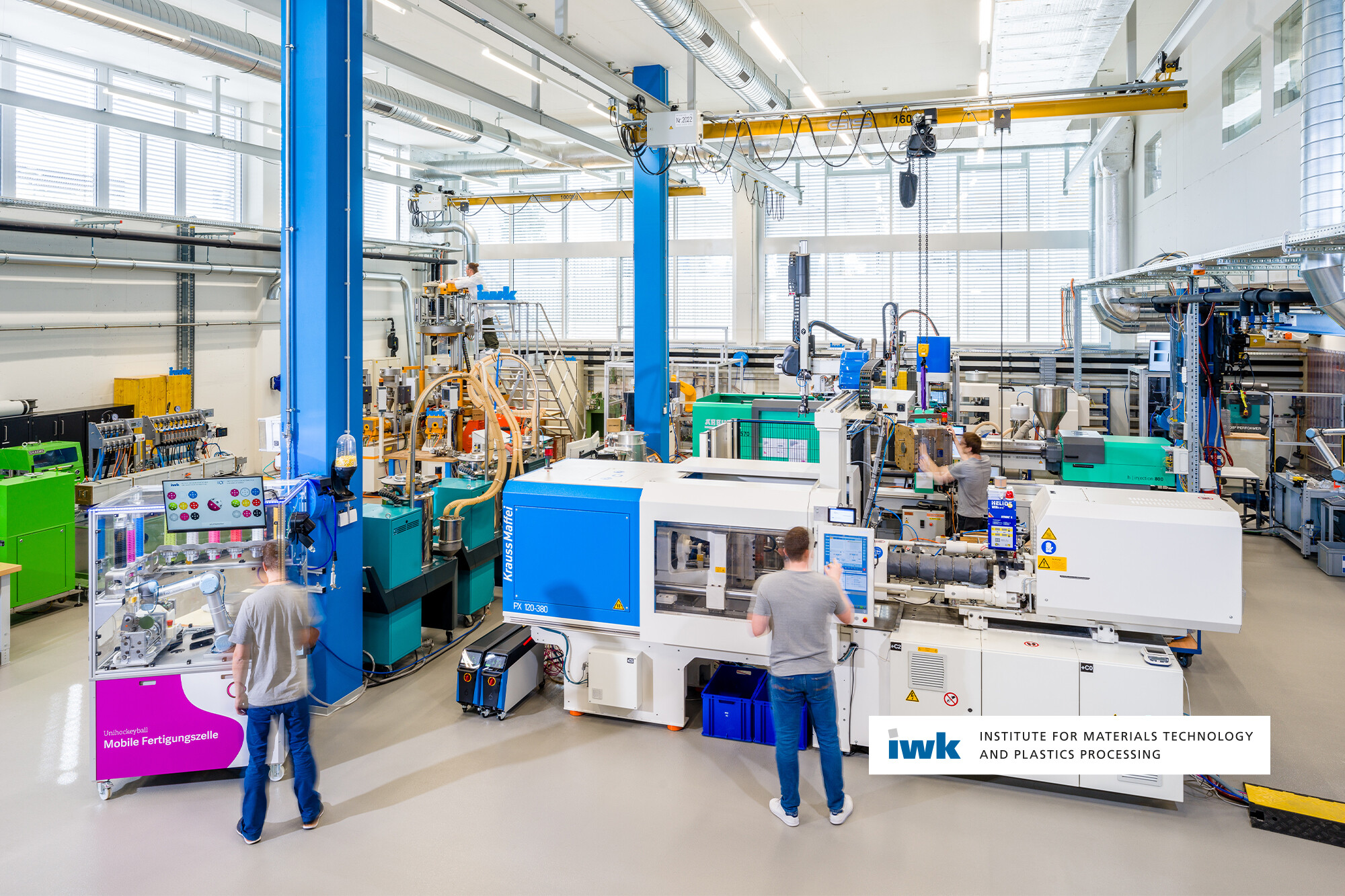Simulation and Design
The interdisciplinary department Simulation and Design acts as an interface at the IWK and deals with comprehensive simulation methods. The focus is on direct or indirect data-based optimization of technical problems in the field of plastics technology and beyond.
Using a wide range of simulation tools and different optimization algorithms, the aim is to quantify and sustainably optimize the extensive interactions between component, material and process.
Core competencies
- Design and dimensioning of components with analytical and numerical calculation methods (finite element method)
- Analysis, verification and optimization of problems in the field of dynamics
- Implementation of design methods suitable for plastics in the simulation environment of ANSYS Workbench
- Generation and parameterization of complex material models for the simulation of the long-term behavior of plastics
- Topology optimization to improve material utilization
- Design of process/structure couplings for integrative and holistic optimization of components with direct consideration of the manufacturing process
- Analysis and optimization of manufacturing processes based on sensor data using machine learning methods
- General data analysis and elaboration of relevant correlations and interactions
- Measurement-based acquisition, analysis and simulation-based optimization of the vibration behavior of arbitrarily excited structures
Technical papers
Reference books
Hopmann, C., Kunz, J., Michaeli, W., Herrlich, N., Land, W. (Hrsg.):
Kunststoffpraxis: Konstruktion. TDS Herrlich GmbH, D-Kirchhain
Aktualisierungsstand 2021
Herrlich, N., Land, W., Hopmann, C., Kunz, J., Michaeli, W. (Hrsg.):
Kunststoffpraxis: Eigenschaften. TDS Herrlich GmbH, D-Kirchhain
Aktualisierungsstand 2021
Kunz, J.: Kunststoff-Laufmantelrollen und ihre kontaktmechanische Auslegung. In: KISSsoft AG (Hrsg.): Schweizer Maschinenelemente Kolloquium 9./10. November 2010 Rapperswil, Tagungsband. TUDpress, Verlag der Wissenschaften GmbH, D-Dresden 2010
Journals
2025
Download Schubbeanspruchung bei Querkraftbiegung
Kunz, J.: Konstruktion_07_08/2025, s. 32-36
2024
Download Schubeinfluss auf die Kräfte am Schnapphaken
Kunz, J., KunststoffXtra 09-10/2024, p. 50-53
Download Statische Bestimmtheit – alles klar?
Kunz, J., Konstruktion 06-07/2024, p. 49-53
Download Nachhaltige Auslegung von Kunststoffbauteilen
Jenni, E., Schmid, D., Studer, M., KunststoffXtra 06/2024, p. 19-21
2023
Download Strukturschaumstoff unter Querbelastung
Kunz, J., KunststoffXtra 10-2023, S. 62-65
Download Kunststoffgerechte Bauteilauslegung in 3D
Jenni, E., Studer, M., KunststoffXtra 07-08/2023, S. 19-21
Download Ein Steifigkeitsmodell für Strukturschaumstoffe
Kunz, J., Konstruktion 01-02/2023, S. 60-64
Download Betrachtungen zur Poissonzahl
Kunz, J., KunststoffXtra 01-02/2023, S. 28-31
2022
Download Dehngrenzen und sprödes Werkstoffverhalten
Kunz, J., KunststoffXtra 05-06/2022, S. 25-28
2020
Ein Leitfaden für die Praxis
Prof. Dr. Pierre Jousset¹, Prof. Dr. Markus Henne², Prof. Dr. Niedermeier³ (¹ Fachbereichsleiter Verbindungstechnik, IWK, HSR Rapperswil, ² Fachbereichsleiter Mechanische Systeme, IWK, HSR Rapperswil, ³ Prof. Dr.-Ing. Michael Niedermeier, Leiter Steinbeis-Innovationszentrum Werkstoff- und Oberflächentechnologie Friedrichshafen und Leiter Werkstoffprüflabor der Hochschule Ravensburg-Weingarten RWU), KunsstoffXtra 4/2020, Seite 34-37
2019
Einfluesse auf die Mikroschaedigungs-Dehngrenzen.pdf
Kunz, J.: Einflüsse auf die Mikroschädigungs-Dehngrenzen. Kunststoffe 109(2019)10, S. 212-216
Druckbelastungsgrenzen abschaetzen.pdf
Kunz, J.: Druckbelastungsgrenzen abschätzen. KunststoffXtra9(2019)11, S. 17-21
2018
Randnotizen zur Gestaltänderungsenergiehypothese
Kunz, J.: Randnotizen zur Gestaltungsänderungsenergiehypothese, Sonderdruck aus Konstruktion 9/2018, S. 53-56
2018 Spannungszustand und Werkstoffverhalten.pdf
Kunz, J.: Spannungszustand und Werkstoffverhalten, Sonderdruck aus KunststoffXtra 8 (2018) Nr. 4, S. 14–18
KU 2018 02 Reversibilitaet-als-Auslegungskriterium.pdf
Kunz, J.: Reversibilität als Auslegungskriterium, Kunststoffe 108(2018)2, S. 67-71
Lectures
2019
Müller, L., Henne, M.: „Effektive Drohnenabwehr aus der Luft: Eine Kombination aus manuellem und autonomem Flug“, MAT-Konferenz (ehemals Mobility-Forum), Bern, 6. November 2019

